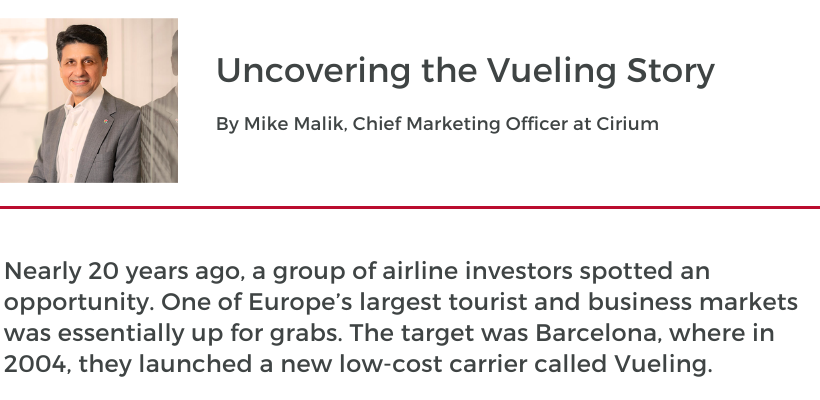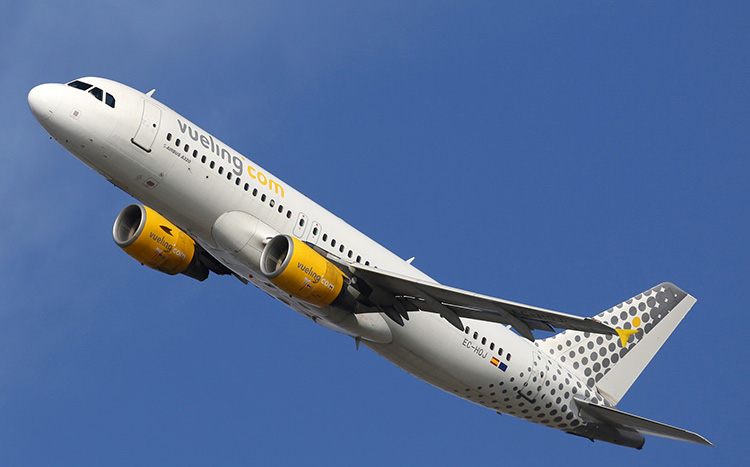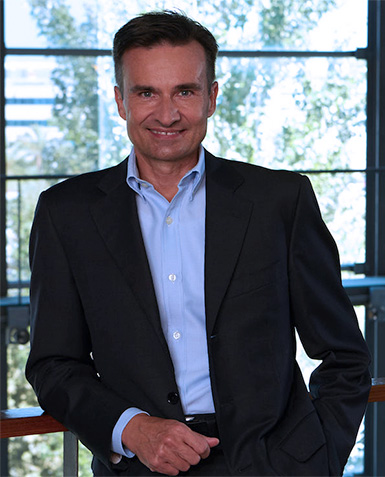
As Cirium’s database of historical schedules shows, Barcelona El Prat was Europe’s eighth busiest airport by seat capacity in 2004. Busier airports like London Heathrow, Paris De Gaulle, Frankfurt, and Amsterdam were largely dominated by British Airways, Air France, Lufthansa, and KLM, respectively.

Spain’s largest airline Iberia was top dog in Barcelona, but most of its attention was focused on the country’s capital Madrid, where it made most of its money flying long-haul to Latin America. This left a void in the fragmented Barcelona market, contested by carriers like Spanair and Air Europa, neither a truly low-cost carrier like JetBlue in the US.
| SURE ENOUGH, VUELING WOULD ADOPT A JETBLUE-LIKE BUSINESS MODEL, KEEPING COSTS LOW BUT PROVIDING MANY PASSENGER AMENITIES AS WELL. |
This would distinguish it from Ryanair and easyJet, both at that time ultra-no-frill carriers. Ryanair, in fact, wasn’t yet flying to Barcelona’s main airport in 2004, instead competing from nearby Gerona and Reus airports. One of those initial Vueling investors knew all about JetBlue’s business model: JetBlue co-founder and later CEO Dave Barger.

Unfortunately for the new startup, the early years weren’t easy. Iberia, unwilling to cede turf to Vueling, launched its own low-cost carrier in Barcelona two years later. Diio figures show that from the summer of 2006 to the summer of 2016, seat capacity at all three Barcelona airports rose by 16%. Vueling itself was partly responsible, growing 30%. But Ryanair’s seats at Gerona and Reus combined were up 41%, while easyJet grew its El Prat capacity 13%. The Iberia-backed newcomer Clickair, meanwhile, was jumping on many of the same routes flown by Vueling. Yields naturally plummeted. Losses spiked.

In 2008, Vueling and Clickair would call a truce to their war of attrition, announcing a merger. The combined airline would retain the Vueling name, but Clickair’s CEO Alex Cruz would be in charge. Iberia would retain an ownership stake. Of course, 2008 and the ensuing several years weren’t easy for any European airline, given the global financial crisis, the eurozone crisis, the popping of the Spanish real estate bubble, and other economic difficulties. None of this, however, deterred Ryanair from expanding. Diio shows the Irish carrier’s Barcelona seat capacity up 73% from the summer of 2008 to the summer of 2012. That includes its entry into El Prat, Vueling’s home airport.
| NEVERTHELESS, THANKS TO FACTORS LIKE STRONG COST CONTROL, EXPANSION FROM PARIS ORLY AIRPORT, IBERIA’S SHORTHAUL DOWNSIZING, AND SPANAIR’S COLLAPSE, CRUZ MADE THE VUELING-CLICKAIR MERGER A SUCCESS. |
It consistently reported profits even during the economic downturn. That made Iberia happy; it was still a shareholder. It also made British Airways happy; BA finalized a merger with Iberia in 2011, inheriting a stake in Vueling. The collection of airlines would be known as the International Airlines Group, or IAG.

IAG was impressed enough to buy full control of Vueling in 2013, keeping Alex Cruz in charge. Vueling would retain its own brand identity and continue to grow from Barcelona throughout the 2010s. Just as importantly, it established a base in Rome where it took short haul traffic from the ailing Alitalia. One of its biggest expansion markets, Diio figures show, was Palma de Mallorca, a busy beach market. Vueling continued to attack Air France at both major airports in Paris. It established a sizable presence at London Gatwick as well. After leading Vueling to consistent profits, Alex Cruz, in 2016, was rewarded with a big promotion: The top job at British Airways.
It wasn’t all smooth sailing for Vueling in the final years of the 2010s. Operational difficulties, often due to air traffic control issues, became a costly problem at times. Competition remained intense, not just from rival low-cost carriers but also Spain’s high-speed rail network. Always challenging in a market like Spain is managing the big swing in demand across seasons, with summers always much busier than winters. Then came the pandemic to start the 2020s.

Fast forward to 2022, and Vueling—now run by CEO Marco Sansavini—is recovering rapidly, more so in fact than most of IAG’s other airlines.
During the group’s latest earnings call, management said Vueling had fully recovered its 2019 revenue and capacity levels, “driven by strong demand domestically and good yield management.” IAG also mentioned Vueling’s strong ancillary revenue performance.
Last year, with traffic still depressed, Vueling embarked on a 19-point transformation plan that included the launch of a new maintenance joint venture, a revamp of its fare families, introducing new ancillary products, and new efforts to de-bundle services from base fares. These initiatives are now aiding the recovery and positioning it for future growth.
| OPERATIONALLY THINGS ARE GOING WELL, VUELING WAS NAMED THE MOST ON-TIME AIRLINE IN EUROPE FOR 2021 AND WON THE REGIONS OTP AWARD FROM CIRIUM. |
Mark your calendars for 2023. Next year will mark the tenth anniversary since IAG took control of Vueling. It surely doesn’t regret it.
























































